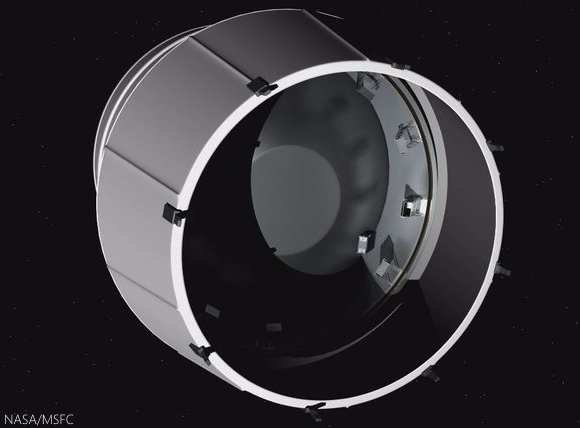 |
| The MSA with cubesats tucked away [NASA/MSFC]. |
Josh Barrett
SpaceAlabama.com
Exploration Flight Test-1, which launched on December 5, 2014 tested the Orion spacecraft. The capsule that would take people to Mars went to space for the first time, and it was one of NASA's biggest accomplishments in 2014. In 2018, the next flight of Orion will be on the Space Launch System (SLS), and it will again be an unmanned test flight. But this time around, there's going to be some extra things sent to space.
The Marshall Space Flight Center is working on getting the most out of the SLS's tremendous lift capability. NASA had the novel idea of tucking away eleven different scientific missions on Exploration Mission-1, which would provide otherwise costly access to deep space.
"What we're really excited about is the fact that we're able to take this test flight and actually get science out of it, and we're expanding the capability," said Joseph Pelfry, a deputy project manager at Marshall, who was instrumental in this idea. "SLS is designed for a lot more payload capability, but we're trying to take advantage of every bit of capability the vehicle has."
Three of the eleven missions have already been selected. The science payloads must fit in to six-unit cubesats, which are efficient and versatile. They will be hidden in the multi-vehicle stage adapter (MSA), which is the ring that connects Orion's service module to the top stage of SLS. Once Orion and the service module disconnect and continue on to orbit the moon, compartments in the MSA will launch the science missions at certain times depending on particular mission.
"Flying these secondary payloads is something we're going to do for missions to come and really provide the science community an opportunity that they haven't had before," Pelfrey said. "That's what the SLS enables beyond the journey to Mars."
Two missions are being designed at Marshall. The Near-Earth Asteroid (NEA) Scout and Lunar Flashlight are already approved. Both will make use of solar sail technology - which uses energy from photons emitted by the sun to create a highly efficient, propulsionless way to explore the solar system.
Read the full post at SpaceAlabama.com, HERE.

No comments:
Post a Comment